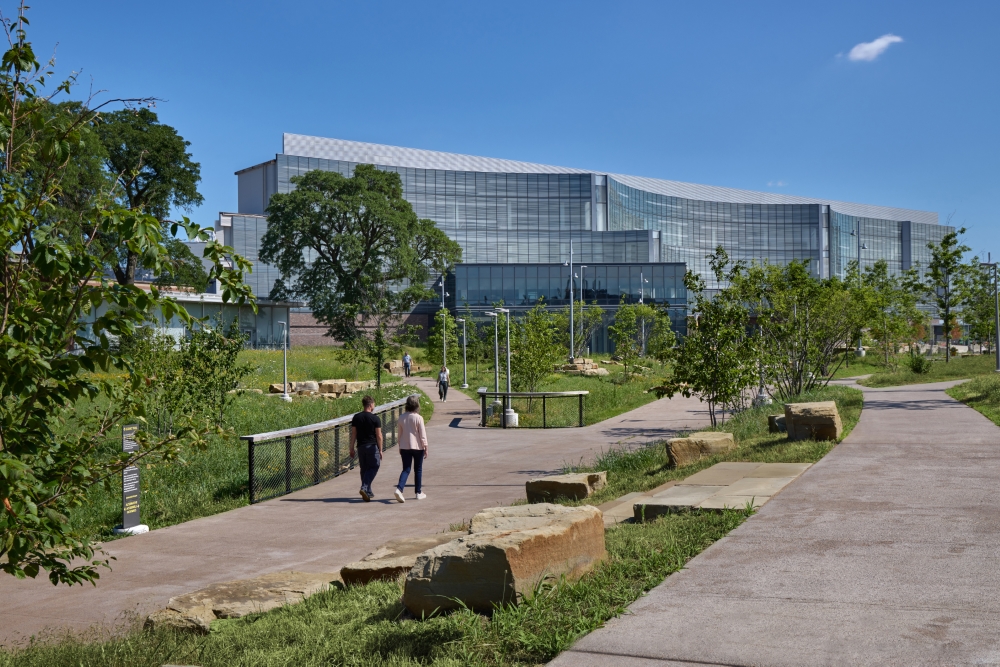The Great Lakes region may be named for its bodies of water. But it’s best known for its body of work.
No economic sector better illustrates that work than the automotive industry. The numbers tell the story: Across the eight U.S. states and two Canadian provinces that comprise the Great Lakes region of North America, Site Selection magazine’s Conway Projects Database has tracked 647 major automotive facility investment projects since January 2020. Michigan (161 projects) and Ohio (151) are the far-and-away leaders, followed by Indiana (99), Illinois (88) and Ontario (63).
More impressive? These 10 territories overall welcomed nearly 38% of all automotive facility investments in North America over that span of time and 24% of all automotive projects in the world … yes, in the world.
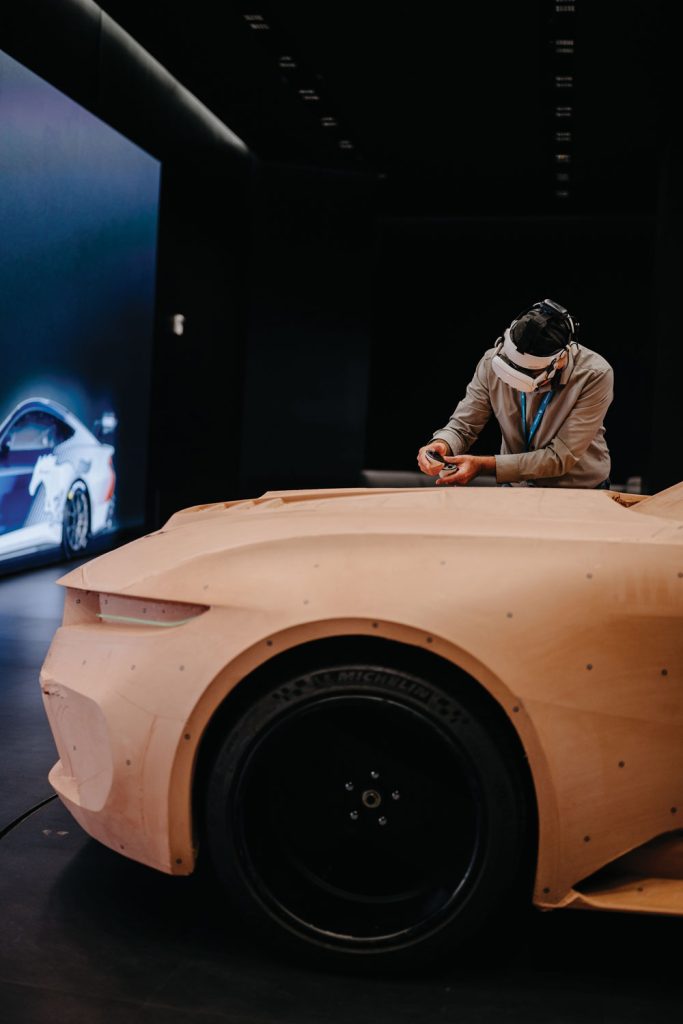
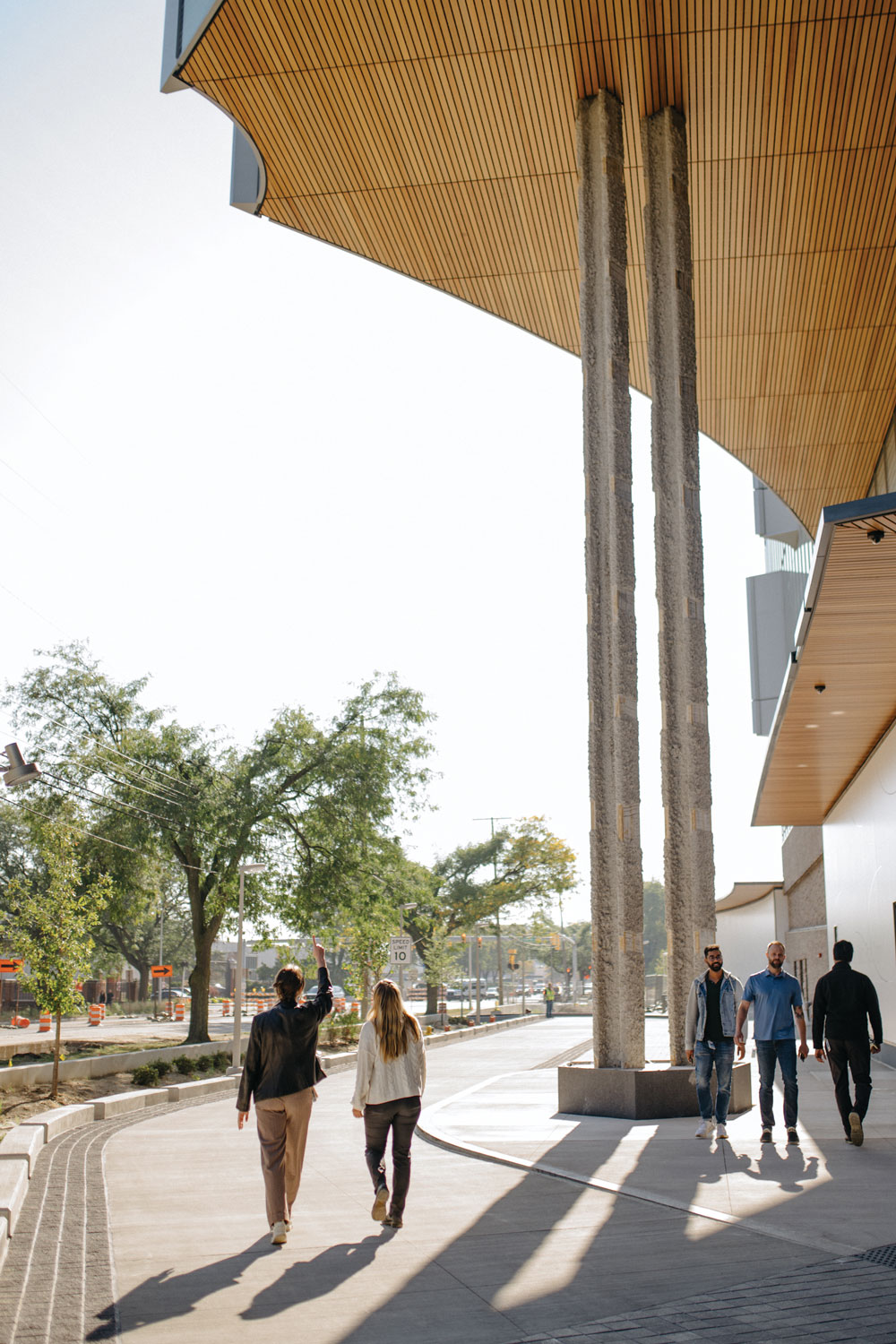
Photos courtesy of FordMotor Co.
So it only makes sense that two of the former Big Three — General Motors and Ford Motor Co. — are demonstrating their devotion to their origins with investments devoted to new headquarters, which some might call quarters for the smartest heads in the business.
Ford Motor Company
The 122-year-old automaker will open a new 2.1-million-sq.-ft. Ford World Headquarters in November 2025, moving from its famous “Glass House” building into a new structure it says “anchors Ford’s refreshed Dearborn, Michigan, campus, bringing cross-functional teams together to collaborate in practice and proximity. This ushers in a new way of working in the name of the next generation of automotive innovation.” The company’s new home, with more than 100,000 sq. ft. of interior courtyard space, is more than twice the size of the Glass House and supports twice the number of employees. Among key aspects:
“Any Ford employee can access collaboration space at the new building, which brings cross-functional teams together through three main types of spaces: Workplace, Amenities, and Unique Programming (Design Studios, Showroom, Fabrication Shops, and Garages) to support different working styles.” A Design Showroom with 10 turntables enables Ford to conduct a full product review in one unified space for the first time.
“When the building is complete, 14,000 employees will be within a 15-minute walk, enabling collaboration in practice and proximity.”
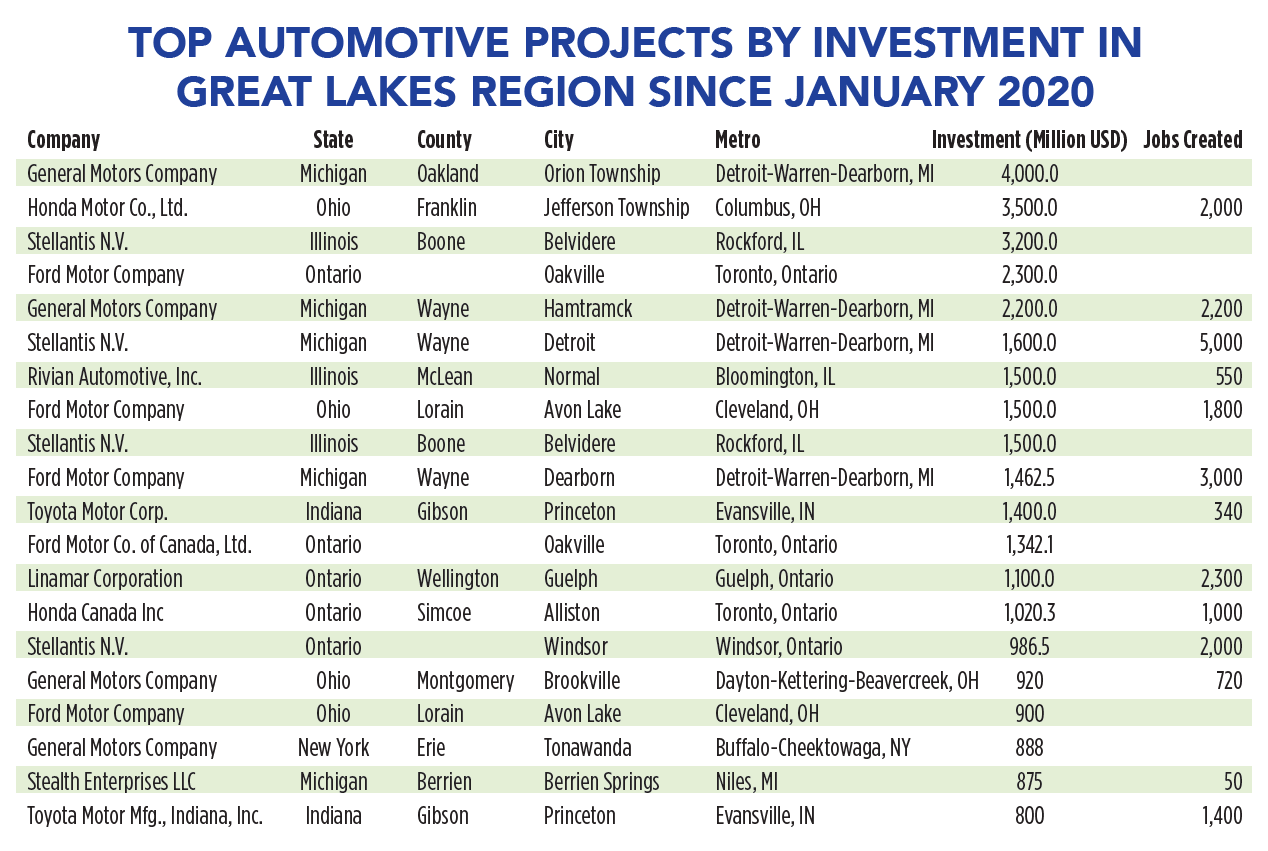
Source: Conway Projects Database/Site Selection magazine
“The building enables free movement of products, as it can accommodate a vehicle almost anywhere. Vertically-stacked layout reduces material movement time by more than 80% compared to the previous Product Development Center, a result of a two-year study leading to the final design of the building.”
“Workspaces are available throughout the building for employees, regardless of their assigned office, enabling collaboration across the Dearborn campus.”
In a letter to all employees delivered on September 15, 2025, Executive Chair Bill Ford and CEO Jim Farley wrote, “This is part of a larger investment in our people and our facilities across the globe. We are committed to providing employees with world-class workspaces, modern technology, and the best tools to do their life’s best work — from our global offices to our manufacturing floors … For nearly 70 years, the iconic Glass House served as the nerve center of our global operations and we honor its incredible legacy. But the future of our industry demands a different kind of space — one that is more connected, more flexible and built for the speed of a technology- and software-driven company.”
At GM, CEO Mary Barra offers a similar message as the automaker moves into a gleaming new office building in the heart of downtown Detroit while it vacates the Renaissance Center.
General Motors
“When you want to recruit executive talent, it’s tough to sell innovators on working in literally a 50-year-old silo,” wrote Automotive News about General Motors’ current HQ in the 1970s-era Renaissance Center. Hence GM’s announcement in April 2024 that it would move into a new global headquarters anchoring Bedrock’s 1.5-million-sq.-ft. Hudson’s Detroit development located in downtown Detroit on the historic site of the former J.L. Hudson Department Store. GM now has entered into an initial 15-year lease for the top floors of the office building as well as street-level showcase space for GM vehicles and community activations.
It’s the company’s fourth headquarters location in the city over the past 114 years, returning to the same street, Woodward Avenue, where it established its first HQ in the city. And just as Ford is working with the City of Dearborn on what to do with the Glass House, GM is working with the City of Detroit, Wayne County and Bedrock to explore redevelopment opportunities for the Renaissance Center site.
In the 17-county area of Northwest Ohio alone, some 230 automotive manufacturing facilities account for nearly 44,000 jobs, or one out of every 11 private-sector jobs in the region.
Source: Center for Automotive Research and Center to Advance Manufacturing, January 2025
“We are proud to remain in the city of Detroit in a modern office building that fits the evolving needs of our workforce, right in the heart of downtown,” said GM Chair and CEO Mary Barra last year. “Dan Gilbert and Bedrock have done so much to make downtown Detroit a great place to live, work and visit. We are thrilled to be a significant part of the historic Hudson’s project and also look forward to working with them to explore new ideas and opportunities for the Renaissance Center site and the riverfront.”
“In my time as mayor, I am proud that our team has worked together with GM and Bedrock to build on the city’s revitalization. Hudson’s Detroit marks a significant development in the city and returns an iconic name back to where it belongs,” said Detroit Mayor Mike Duggan. “GM, meanwhile, is already building EVs at its Factory ZERO plant, located here in Detroit. I am equally excited to see what these two great companies imagine when it comes to the future redevelopment of the Renaissance Center.”
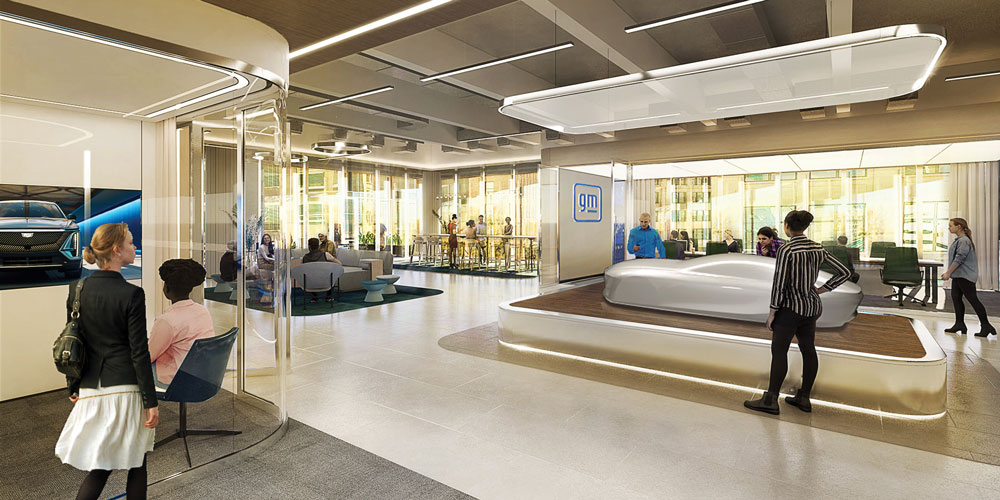
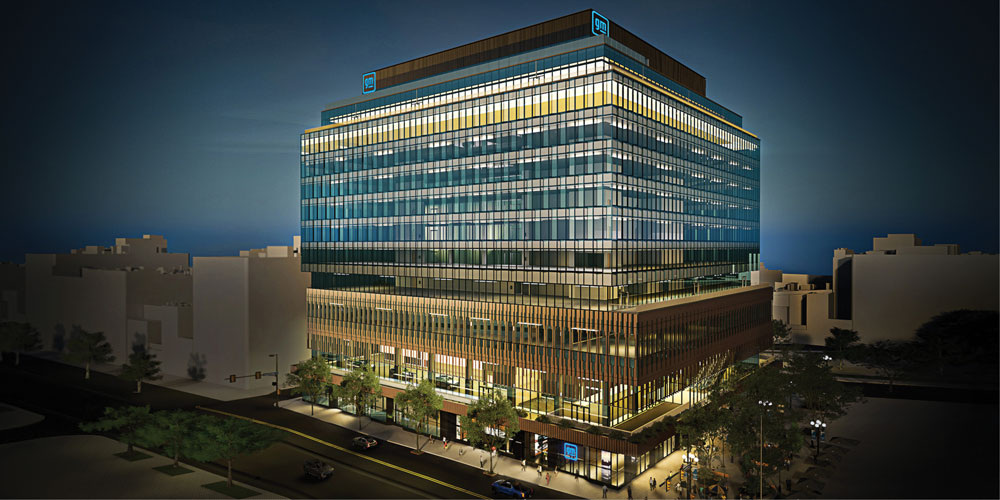
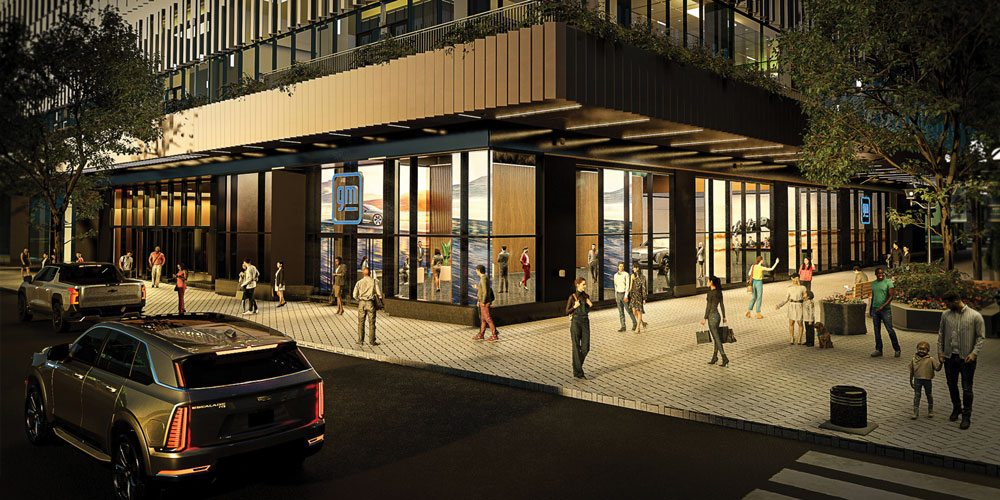
GM is moving its HQ from the Renaissance Center to a new office building that is part of the 1.5-million-sq.-ft. Hudson’s Detroit development from Dan Gilbert’s Bedrock. It stands on the site of the original Hudson’s department store that opened in 1891.
Images courtesy of GM
GM invested $2.2 billion in Factory ZERO (formerly the Detroit-Hamtramck Assembly Center) in November 2020 for retooling and upgrades to build a number of Ultium-powered EVs. The plant, which today employs nearly 4,000 people, was first built in 1985 and has manufactured over 3 million vehicles, GM says. One of the company’s two Ultium Cells battery plants is in Warren, Ohio.
Summer 2025 saw the company announce plans to invest about $4 billion over the next two years in its domestic manufacturing plants to increase U.S. production of both gas and electric vehicles, including investments in Kansas and Tennessee as well as at its Orion Assembly plant in Michigan and an $888 million investment near Buffalo, New York, to support GM’s next-gen V-8 engine. In September 2025, the company celebrated 117 years in business as the State of Michigan officially declared it to be “GM Day.”
“Today, we have 38 facilities, 210 dealers in our network, and we work with over 1,000 tier-one suppliers with locations across the state,” the company said of its Michigan portfolio, part of a network of 50 U.S. manufacturing plants and parts facilities in 19 states. “GM is the largest automotive employer in Michigan — the automotive capital of the world — with about 50,000 employees. We’re not just building vehicles, we’re helping to support the futures of tens of thousands of Michiganders.”
The U.S.-Canada Connection
In September, Invest Ontario announced it is supporting a C$1 billion-plus investment by Linamar Corporation spanning six projects in Ontario and creating more than 2,300 jobs in a province that’s home to more than 20,000 advanced manufacturing firms and more than 800,000 manufacturing workers.
“Out of the 75 manufacturing facilities around the world, our Canadian operations are our most productive,” said Linamar President and CEO Linda Hasenfratz in a film produced with Invest Ontario about the announcement. “It’s a big reason why they’re winning so much business … Nearly 10,000 employees right here in Ontario who live and breathe continuous improvement and innovation every single day. They set the standard for our global operations.”
Linamar’s employees are part of more than 100,000 workers directly employed by Ontario’s automotive sector, which includes more than 400 companies engaged in connected and autonomous development and smart mobility backed by 36 automotive-focused programs at Ontario colleges and universities.
The only subnational jurisdiction in North America to have five major automotive assemblers (Ford, GM, Honda, Stellantis and Toyota), Ontario in 2023 welcomed Volkswagen Group-owned battery company PowerCo’s choice of the province to build its first battery cell factory in North America. And Ontario is at the heart of the all-Canadian Project Arrow EV concept car.
